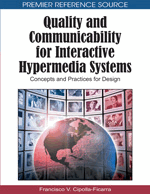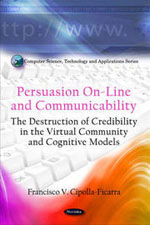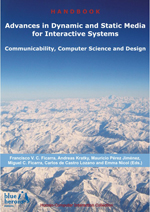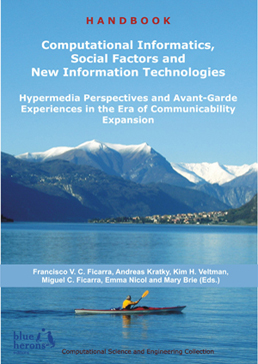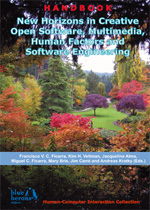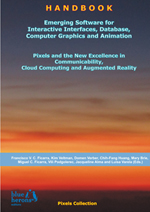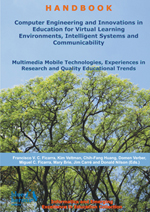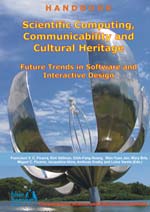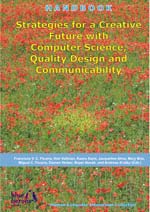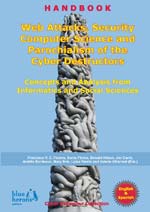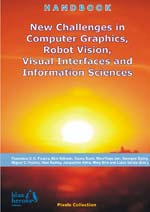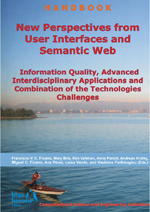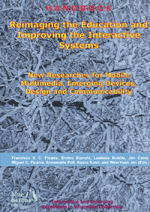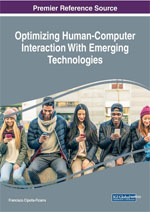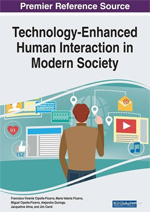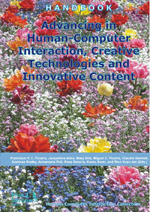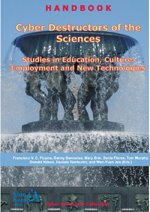New Perspectives from User Interfaces and Semantic Web: Information Quality, Advanced Interdisciplinary Applications and Combination of the Technologies Challenges
:: Computational Science and Engineering Collection ::
:: Revised Selected Chapters ::
Main Editor: Francisco V. C. Ficarra
Co-editors: Mary Brie (La Valletta, Malta), Kim Veltman (Maastricht, Netherlands), Anna Parodi (Rome, Italy), Andreas Kratky (Los Angeles, USA), Miguel C. Ficarra (Spain and Italy), Ana Pérez (Sevlle, Spain), Luisa Varela (Perpignan, France), and Vasileios Paliktzoglou (Joensuu, Finland)
Editorial Assistants: Jim Carré (Willemstad, Curaçao) and Donald Nilson (Norway, Oslo)
Book Details
• ISBN: 978-88-96471-46-3 :: DOI: 10.978.8896471/463
• Publisher: Blue Herons Editions
• Location: Italy (Bg)
• Subjects: User, Interface, Design, Evaluation, Usability, Communicablity, Quality, Software
• Subjects: Information Architecture, ICT, Hardware, New Media, Semantic Web, Multimedia
• Subjects: iOS, Apps, Social Neworking, Semiotics, Psychology, Bipolar Disorder, UX, VR
• Subjects: Cultural Heritage, 3D, Interaction, Computer Graphics, Triphase Disorder, Testing
• Subjects: Medical Information, Algorithm, Machine Learning, Education, Slavery, U-learning
• Subjects: e-Tourism, Raster Graphic, Mobile Telephony, Cyber Attacks, Cyber Terrorism
• Subjects: Carrier-Ethernet Technologies, Telecommunication, Vector Graphic, Infographics
• Subjects: Statistics Collection, LRU Stack Distances, R&D, CAD, Industrial Heritage, LAN
• Subjects: Mobile Applications, Ambient Display, Computer Vision, Tangible User Interface
• Copyright: 2016
• Collection: Computational Science and Engineering
• Series volume: III
• Publication date: December, 2016
• Binding: Paperback
• Grade level: General
• Language: English
• Illustrations: Yes
• Colour: Yes
• Pages: 182
• Dimensions: 11.41x8.26x0.4 in. 1.29 lbs. :: 290x210x13 mm. 587 gr.
Preface
Genius is 1% talent and 99% hard work.
Albert Einstein (1879 – 1955)
One goal of the current handbook can be drawn through the history of the internet and semantic web. There are four essential dates: The first is the development of the world wide web in 1989 by Timothy Berners-Lee. He sought from its inception to include semantic information. However, at the time and because of different reasons it wasn’t possible, thus remaining one of the open lines of research in the computer science context, of a great impact and scientific interest, as it has been verified over time, especially with the democratization of the Internet in the 90s.
In 1993 the first Web servers and the Mosaic navigator appeared. In 1994 the activities of the World Wide Web Consortium (W3C) started. Finally in 1997 the SHOE (Simple HTML Ontology Extensions) appear, that is, the first forerunner of the semantic web, based on HTML: Since the start, the goal has always been to improve the performance of the Internet widening the interoperability through intelligent agents, for instance. That is, those computer programs which seek information without any need of resorting to the human being. Consequently, reaching that main goal entails a subset of secondary goals.
Those are goals which entail having a wide vision not only of the present but also for the future in the short, mid and long term. Goals related to the new techniques and paradigms for the representation of information and knowledge. All of this entails facilitating tasks whether it is in locating the information as well as integrating it and sharing it among different types of potential users, to mention some of them.
These tasks entail the continuous intersection of the formal and factual sciences, where there are disciplines belonging to software engineering, the interactive design of user interfaces, the databases, the information architecture, etc. In short, a variegated set of domains, fields and specialities as it can be seen in the listing of the main subjects, without excluding others of great interest or impact, of those research works which will make up the core content of the current book.
Some of them are: the use of interfaces to facilitate the interaction among the users and the access to the information in the databases, the applications of the semantic web, the methods and/or techniques used in other fields of the social sciences, for instance, and which can be adapted to the semantic web to boost its progression in the context of research, etc. This opening towards other scientific fields makes that the main and secondary subjects of interest in the current proceeding may be mistakenly understood as expanded. However, said subjects denote new areas of research in the future of the semantic web, with the purpose of improving the quality of performance of the internet.
In other words, we intend to create a kind of vademecum of the internet and semantic web, for the constant consultation of the current and future professionals interested in these topics. Besides, some contributions collected in the book have been evaluated and corrected prior to publication in an anonymous way by an international scientific committee. In some cases, said studies have been put forward orally (papers, short papers, research-in-progress, posters, etc.), with their corresponding demos, that is, accompanied with practical/theoretical cases in international conferences, workshops and symposiums such as: MSIVISM (International Conference on Multimedia, Scientific Information and Visualization for Information Systems and Metrics), SETECEC (International Conference on Software and Emerging Technologies for Education, Culture, Entertainment, and Commerce), CCGIDIS (International Symposium on Communicability, Computer Graphics and Innovative Design For Interactive Systems), HIASCIT (International Conference on Horizons for Information Architecture, Security and Cloud Intelligent Technology), HCITOCH (International Workshop on Human-Computer Interaction, Tourism and Cultural Heritage), ADNTIIC (International Conference on Advances in New Technologies, Interactive Interfaces and Communicability), HCITISI (Argentine Conference on Human-Computer Interaction, Telecommunications, Informatics and Scientific Information), RDINIDR (International Conference on Research and Development in Imaging, Nanotechnology, Industrial Design and Robotics), and ESIHISE (International Conference on Evolution of the Sciences, Informatics, Human Integration and Scientific Education). Now, a short summary of the chapters that make up the current handbook is given:
In the chapter “Usability Engineering and Communicability for Information Architecture: A Logical Metamorphosis”, the author presents the evolution of usability in the 90s towards the communicability of the new millenium. In this research are presented in the first place the theoretical concepts which have set up the foundations for usability engineering. Later on, a parallelism is drawn with the evolution of the hardware, pointing out besides how many notions have been overcome with the passing of time. For instance, with the democratization of the internet and the access to online information by millions of users in the whole planet. Besides, the motivations are explained why there are still university centres that use the archaic notion of usability, or wild marketing, user experience, at the moment of carrying out the evaluation of the interactive systems. There is also a brief study of the new multimedia mobile phones that denotes the importance of communicability from the 21st century onwards, whether it is in the architecture of the information as in the device of the interactive systems. A set of examples from the European and American continents are presented where the notions of usability and user experience are used not with scientific and/or educational purposes but rather for the expansion of the “G” factor in certain university educational centers related to the new information technologies.
Under title “Continual Attacks On-line and Off-line: Authors with Bipolar or ‘Triphase’ Disorder?”, a large number of examples of real actions are described, in the context of ICTs and all their derivations, where the behavior of the authors/characters/actors reflects bipolar disorders, for example. The chapter explains how these patterns of behaviour compromise the normal development of scientific knowledge and technological progress, especially in the field of software engineering. The phenomenon of “triphase disorder” is also explained, in the behavior of the actors that are described. Throughout the research, there are several cases of study where that behavior ignores the limits before the legal immunity. One of the fundamental objectives is the continuous expansion in the current issues, leaving aside the scientific and/or educational aspect. The financial motivations for which the fashion of those subjects of study is finalized, the groups of works like the supposed lines of research for the future, in the short, medium and long term, are abandoned immediately. A first analysis of the impact of these patterns of behaviour in the economic sphere of the communities in which these actors/characters/authors are inserted with bipolar or triphase disorder. The texts, diagrams, tables, illustrations, etc., are presented with some elements from the comics and/or humor to facilitate understanding and reduce the impact of the seriousness of the topic addressed in the chapter.
The research work “The Multi-Edge Approach for iOS Applications Testing” has been developed by the following authors: Ivans Kulesovs, Juris Borzovs, Aigars Susters, Vineta Arnicane, Guntis Arnicans, Kirils Keiduns, and Janis Skutelis. These authors study topics of great impact in the current software industry, such as mobile telephony, apps, iOS, testing, and test automation. The chapter describes the multi-edge approach for iOS applications testing. It includes the overall software testing field review on meta-level, the complete list of aspects that influence testing the functional suitability, performance efficiency, compatibility, reliability, maintainability, and portability of iOS native business applications, for example. Beside, the research work gives insight into functional security testing of iOS apps, and shares the experience of UI automated testing of iOS apps using tTap extension for Apple UI automation. The authors have included in this regard, an extensive and varied set of references. The structure of the chapter is of progressive type, that is to say, the general notions are passed to the most specific concepts, using a positive didactic mechanism for the issues raised. Some topics that have been structured as follows: Inventory of testing ideas and structuring of testing terms; iOS applications testing; Functional security testing of iOS apps, automated testing of iOS apps; tTap Extension for Apple UIAutomation; among others. It is important to note that each of these sections is very well explained through the use of illustrations and tables that speed up the understanding of the topics covered.
José Luis Hamkalo, Facundo Spagnuolo and Bruno Cernuschi Frías are the authors of the research named by them “Environment for Statistics Collection for LRU Stack Distances.” In the chapter an environment for statistics collection for LRU (Least Recently Used) stack distances is presented. It is a work aimed at optimizing the memory of computers, through an analysis tool. Therefore, some of the central axes of the work are oriented at Data visualization; Cache memories; Replacement policies, and LRU stack distances. The authors highlight the analysis of the LRU stack distances for the memory references of an application through an innovative instrument for this study topology. The tool allows the capture and display of the above distances, which are of fundamental interest for the study and design of memory hierarchies. The work has an excellent pedagogical level and the topics are developed in a didactic way, in each of the sections, which can briefly be presented and summarized as follows: LRU distances stack are described; the proposed tool is presented; traces of references are analyzed in order to validate the tool, and finally conclusions and future works are given. The figures that accompany the text are screenshots of the application, and in them you can see the correct functioning of the tool made by José Luis Hamkalo, Facundo Spagnuolo and Bruno Cernuschi Frías.
The authors of chapter “Improving Visitors Experience: Latium Welcome Centre in Civitavecchia” are Amedeo Perrone, Massimiliano Dibitonto, Valerio De Cecio, and Carlo Maria Medaglia. As a fundamental objective, its authors have proposed in this paper to explain the experience in the design of a real project for a cultural center, located in Cittavechia, that is, a few kilometers from Rome. It is an chapter that denotes the presence of notions related to the cultural heritage, cultural spaces, natural interaction, mobile applications, ambient display, computer vision, tangible user interface, among others. In addition, the authors are very aware of the fact that they are immersed in a classic Latium region. This reality is very important from the point of view of the tourist potential that this area encompasses, which is why the theoretical concepts presented are very valid, to be applied to other analogous situations in the field of European cultural and tourist heritage, for example. The major areas of content of the chapter are: Interactive technologies inside cultural spaces; Latium region welcome center; Related and future works. In the present study it is possible to verify which are the riches of the cultural patrimony that can be acceded by the tourists, in each one of the places that they are visiting, and in a precise way. This is another of the implicit objectives of the project, that is, to enhance the cultural activities of the visitors. In the images that illustrate the text you can progressively get to know the different interfaces generated in the project as well as the various technological supports used to attract the attention and enjoyment of tourists.
Under the title of “Carrier-Ethernet Technologies”, its authors, Daniel Biga, Fernando Dufour, Ariel Serra, and Carlos Peliza present a research work related to Carrier Ethernet. Ethernet is a technology originally designed for the simple exchange of data across a local area network (LAN) in campus or companies, nevertheless its success has increased the needs of its services to larger areas, such as MAN and WAN networks. The authors describe the main advantages of using these technologies in telecommunications. The study begins with a state of the art and the possibilities offered to customers distributed in large geographical areas, offering a powerful and high quality service. Simultaneously, they have compiled information from the specialists of these technologies, adapting them to the reality of the networks with which they work and / or usually experience, in order to establish forecasts in the short, medium and long term. Throughout the various sections, each of the objectives set out at the beginning of the chapter are developed in a descriptive manner, and following superlative didactic parameters, since the text is accompanied by graphs and tables, where results are represented, as well as the trends or opinions of experts with reference to these technologies in the immediate future. In this sense, Daniel Biga, Fernando Dufour, Ariel Serra, and Carlos Peliza have been constantly collecting information, which has been processed and adapted to the reality on which they are working and / or investigating on a daily basis.
With the title of “Graphic Representation of Technical Information: The Industrial Heritage of Sugar in Granada” his author Jorge Rodríguez Gómez presents an investigation which refers to the industrial heritage in Andalusia, especially with the sugarcane industry in Granada. Through the diverse areas that make up the research, it can be seen that we are facing a graphic representation of technical information, with an optimum quality. As categories and subject descriptors, the following are indicated: Design, image processing, and computer-aided design. Some keywords that can target the content of the chapter, from the perspective of the digital image are: raster graphic, vector graphic, and computer graphics. From that moment on the current research deals with the sugar industry developed in the region of Granada (Spain) between the end of the ninetieth century and the beginning of the twentieth century. Besides, the present study is generating the result of multimedia materials supported in the research carried out. The text is accompanied by excellent illustrations, drawings and animations generated by Jorge Rodríguez Gómez, adding exceptional artistic value in the present research work.
“Collaborative Recommendation for e-Tourism: New Algorithm” is the title with which its authors –Firas Ben Kharrat, Aymen Elkhlifi and Rim Faiz, have carried out the research, focused on the following main topics: recommendation system, tourism recommendation, collaborative filtering, and machine learning. The research work has been structured as follows: related works, central approach of the problem to be solved and the paths to follow for its resolution; implementation and detailed explanation of the algorithm developed by the authors, together with a set of examples; experiments to demonstrate the potentiality of the algorithm developed. The approach has been implemented in Java and tested on e-Tourism website. In this sense, a series of graphs are presented with the results obtained. Besides, the results obtained have been very positive because facilitate the didactic comprehension and the breadth of the work carried out by the authors. By the way, the authos present two major tasks in this research. The first one is gathering and parsing of data. The second one is using intelligent recommendation to come up with relevant suggestions. Finally, the chapter closes in a summary manner with a related work, conclusions and future work.
In the research work “Giving away Scientific Knowledge and Enslaving the Future of Professionals in ICTs: Towards a First Sociological Vision of Computer Science Education”, the author presents a first set of direct observations and the analysis of the existing reality over several decades, in some nations of the European and American continent, with reference to how computer knowledge is given, ICTs, HCI, etc., to the outside. The study begins with a series of words, generated from a wild educational marketing, that only serves to enslave the professionals, their families and the communities where they belong. From the point of view of sociology those communities are analyzed that are rich for maintaining a free access system, to secular and university education, for example. However, they are very poor, in defense systems or mechanisms for their native models, which for centuries, has allowed them to access a public university education for all. At the same time, from the perspective of social communication, sociology and social psychology, situations of a spiral or continuous cycle of poverty are studied, where ICT professionals are marginalized, with a high level of training and work experience, to defend the local models in front of the globalization of the “exotic university education” and “canned”, with dubious academic quality, and under the label of “educational excellence”. In the work, the main failures of educational models in the communities where they are manufactured are studied, and then they are tried to sell in other realities, through neocolonialism.
In the research called “Personalization Module for U-learning Applications”, its authors focus their study on the ubiquitous learning. Although it is an area of education that already has several years of development in the northern hemisphere, the increase in the use of new technologies, such as tablet PCs, multimedia mobile telephony, etc., always draws attention to the students, teachers, tutors, etc., in other latitudes of the south of the terrestrial globe at the moment they begin to interact with these new devices. The chapter presents the design of the personalization module, which is part of the architecture, describes its functions and presents to use case with examples of the rules that the inference machine uses to personalize different aspects of an ubiquitous application. In this regard, it is necessary to highlight the following keywords that can serve as a reference to all those interested in the subject: Ubiquitous learning, Ubiquitous computing, Ontologies, Inference machine, Context-aware, to name a few examples. Additionally, some of the main sections of the chapter can also reinforce this operation of orientation in the developed topics: personalized education, personalized e-learning systems, ontological model-driven architecture for ubiquitous learning applications, and Learning Scenario: personalization module in practice. The figures and tables facilitate the task of understanding the study carried out, such as the extensive references that can be found at the end of the chapter.
The study called “Social Web for An Infinity Ballooning System (IBS)” describes a typical European phenomenon, which has its origins in the obtainment of university degrees without academic rigor. Qualifications that have been favored by the prevailing political context, as has been the chaos in the implementation of the Bologna model in the EU. Today those professionals are responsible through the social networks for spreading false news, deleting criticism of their illicit actions, discrediting other people for free, influencing decision-making at the top level of business or industrial management, destroying groups of works, associations, organizations, etc., with absolute immunity from the legal point of view, freely practice stalking, bossing, mobbing, etc. In the present study, some case studies of European universities are analyzed, and taking as a point of reference some students who have reached the maximum level of university degrees, such as the doctorate, using the ballooning system. An analysis of the diachronic nodes of this network is constituted by the following educational and labor institutions: Charles III University of Madrid (Spain), University of Valence (Spain), University of Lleida (Spain), University of the Basque Country, Pompeu Fabra University (Spain), University of Bergamo (Italy), University of Bolzen (Italy), Bruno Kessler Foundation (Italy), University of Trento (Italy), Springer Nature (Germany), etc. Finally, the role of journalists in consciously and/or unconsciously promoting the Infinity Ballooning System (IBS) is presented.
Under the title “Old Usability Problems and New Interfaces for a Medical Information Point: A Case of Study”, the authors Francisco V. C. Ficarra and Giselda Verdone analyzing the archaic problems of the notion of usability, applied to the interfaces in the information systems in public hospitals in Lombardy. In the study it can be seen how there is an involution in the design of the interfaces and the use of the principles of usability in interactive systems in some European regions, that supposedly and historically are considered as the motor of Europe, such as abc. In one of them, an information system is implanted, which instead of reducing the costs of the service, increases them considerably, as can be seen in the figures that accompany the present study. In addition, this study highlights how usability is a notion used together with the user experience in an erroneous way and with purely promotional purposes, which can respond to “narcissism”, when it is used for self- promotion as some applications of social networks are, such as Facebook, Twitter, LinkedIn, Google+, YouTube, etc., or of “publicity or propaganda”, when it comes to justifying camouflaged actions of neocolonialism, by “pseudo professionals” that pretend to demonstrate a nonexistent and interrupted experience in those notions from the 90s to the present. Finally, there are some examples, accompanied by a first vademecum, which serve to detect and eliminate those problems.
Francisco V. C. Ficarra
Fuerteventura, Spain (December 2016)
Partial Content On-line (pdf format)
• Front Cover (here)
• Preface :: Acknowledgment (here)
• Chapters :: Final Remarks :: Author Index :: Keywords Index :: References ... (here)
• Back Cover (here)
Additonal Handook Info
• Only paper copy – no digital book on-line and/or off-line –
• Special Price € 95 (expedition cost not included) ... e-Commerce :: Info Form
Welcome to Blue Herons Editions!
The origin of this publishing project is to be found in the Canadian lands, where nature presents itself generous in many places of its wide geography. More...
Education, Communicability, Design, Computer Science, HCI, Computer Graphics and Computer Animation:
We focus on education and new technologies with 36 years long experience. More...
Literature and Journalism:
Intersection between universal literature, local new journalism (true stories), sociology and legal immunity. Two collections:
- Casoncelli Bergamaschi
It is a typical bergamasque dough filled with meat, similar to the raviolis. More...
- Menjar Blanc & Black
It is a typical sweet of the Catalan coast and the Balearic Islands. More...
Others Releases:
See all others new releases in books, CD, DVD, etc. More ...

Call for Papers, Short Papers, Posters, Demos, Research-in-Progress, Workshops, Doctoral Consortium, Hardware & Software Companies - Didactic Demos Sessions ...
ADNTIIC 2018 :: HCITOCH 2019 :: SETECEC 2019 :: HIASCIT 2019 :: CCGIDIS 2019 :: IPCTIIC 2018 | HCITISI 2018 :: MSIVISM 2019 :: RDINIDR 2018 :: ESIHISE 2018 :: HCIHEART 2019 :: QUITANS 2019


